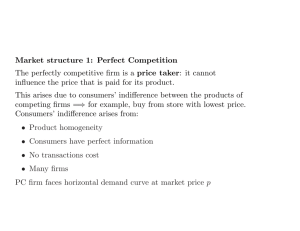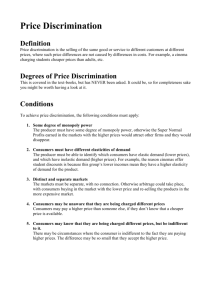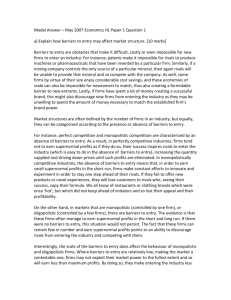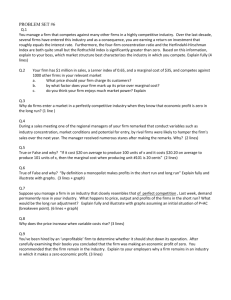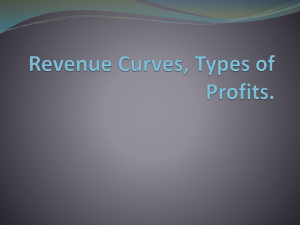lecture 13: market structures
advertisement
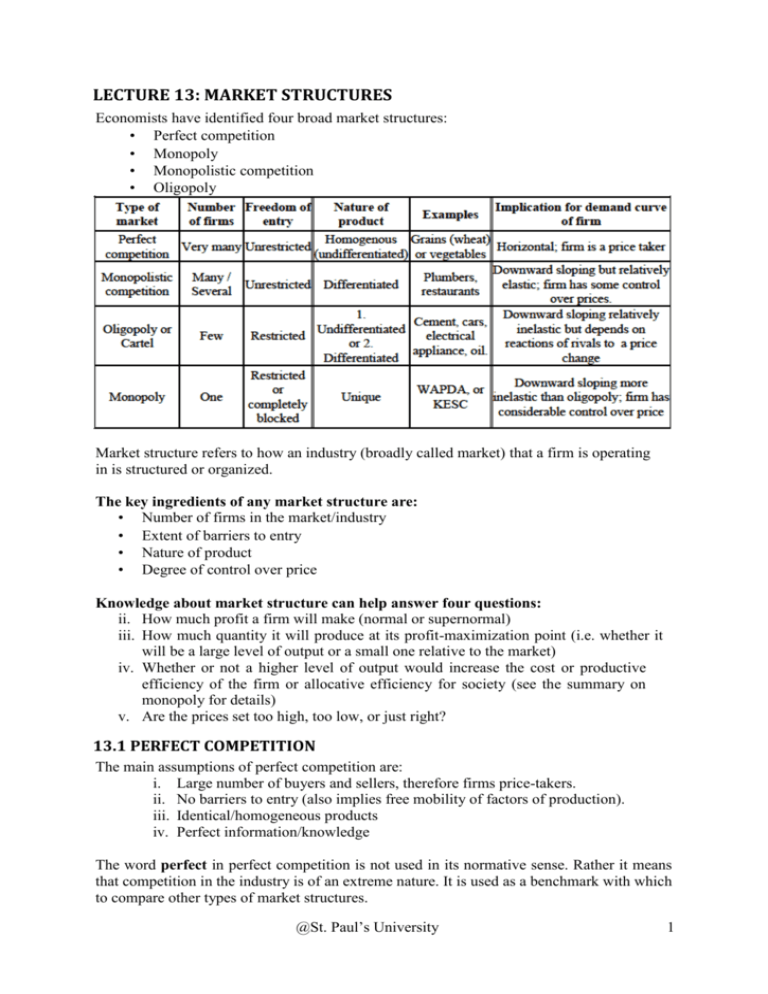
LECTURE 13: MARKET STRUCTURES Economists have identified four broad market structures: • Perfect competition • Monopoly • Monopolistic competition • Oligopoly Market structure refers to how an industry (broadly called market) that a firm is operating in is structured or organized. The key ingredients of any market structure are: • Number of firms in the market/industry • Extent of barriers to entry • Nature of product • Degree of control over price Knowledge about market structure can help answer four questions: ii. How much profit a firm will make (normal or supernormal) iii. How much quantity it will produce at its profit-maximization point (i.e. whether it will be a large level of output or a small one relative to the market) iv. Whether or not a higher level of output would increase the cost or productive efficiency of the firm or allocative efficiency for society (see the summary on monopoly for details) v. Are the prices set too high, too low, or just right? 13.1 PERFECT COMPETITION The main assumptions of perfect competition are: i. Large number of buyers and sellers, therefore firms price-takers. ii. No barriers to entry (also implies free mobility of factors of production). iii. Identical/homogeneous products iv. Perfect information/knowledge The word perfect in perfect competition is not used in its normative sense. Rather it means that competition in the industry is of an extreme nature. It is used as a benchmark with which to compare other types of market structures. @St. Paul’s University 1 Perfect competition can be thought of as an extreme form of capitalism, i.e. all the firms are fully subject to the market forces of demand and supply. Concentration ratio is used to assess the level of competition in an industry. It is simply the percentage of total industry output that is produced by the five largest firms in the industry. 13.2 PROFIT MAXIMIZATION UNDER PERFECT COMPETITION IN THE SHORT RUN The short run is the period where at least one factor of production is fixed. In perfect competition, it also means that no new firms can enter the market. Equilibrium analysis can help us answer questions about the market-clearing price and quantity; where the profits are maximized and how much are these profits; how individual firms make their short run supply decisions and how these translate into the long-run industry supply curve. In the short run, a perfectly competitive firm can settle at equilibrium where it is making super normal profits, normal profits, loss, or where it decides to shut down. In the short run, the firm’s supply curve is identical to the positive part of MC. The short run industry supply curve is simply the horizontal summation of the supply curves of individual firms. The demand (or AR) curve for the industry is downward sloping but for any individual perfectly competitive firm, is horizontal. Thus, the firm can sell as much at the given market price. For this reason, the AR and MR curves align under perfect competition. 13.3 PROFIT MAXIMIZATION UNDER PERFECT COMPETITION IN THE LONG RUN In the long run, all the factors of production are variable. In the long run, any firm can enter or leave the industry. If there are supernormal profits in the short run, more firms will be attracted to the market and the increase in supply will push prices down to eliminate supernormal profit possibilities in the long run. By contrast, if firms are making losses in the short run, they will leave the industry in the long run causing supply to fall, prices to rise and normal profitability to be restored. In the long run, therefore, perfectly competitive firms can only earn normal profits. 13.4 ALLOCATIVE EFFICIENCY AND PRODUCTIVE EFFICIENCY Public interest is concerned with both allocative efficiency and productive efficiency. a. Allocative efficiency: The optimal point of production for any individual firm is where MR=MC. The optimal point of production for any society is where price is equal to marginal cost. This is called the point of maximum allocative efficiency and is achieved in perfect competition (because MR=MC, and MR=AR=P for a perfectly competitive price taking firm, therefore P=MC). b. Productive efficiency: This is attained when firms produce at the bottom of their AC curves, that is, goods are produced in the most cost efficient manner. Perfectly competitive firms also achieve this in the long run because they produce at P=MC and this intersection point also happens to be the point of tangency with the lowest part of the AC curve. Thus P= AC minimum. @St. Paul’s University 2 13.5 MONOPOLY Monopoly defines the other pole or extreme of the market structure spectrum. Usually refers to a situation where there is a single producer in the market. However, it actually depends upon how narrowly you define the industry. 13.6 MONOPOLY POWER Economists are often interested in how much monopoly power any firm (not necessarily a monopoly) has. Here monopoly stands for the extent to which the firm can raise prices without driving away all it customers. In other words, monopoly power and price elasticity of demand are inversely related. Firms whose customers are more have more monopoly power. A monopolistic firm faces inelastic demand of the product & its demand curve is negatively sloped. While in perfect competition, demand curve has infinitely elasticity. 13.7 PROFIT MAXIMIZATION UNDER MONOPOLY In monopoly, firm earns profit when MC=MR and MC curve cuts the MR curve from below. MC curve is not the supply curve of the firm as it was in the perfect competition. This is also the major difference between monopoly & perfect competition. i. The profit maximizing or best level of output is given where MR=MC. Price is then read off the demand curve which is downward sloping. Note however, the difference with perfect competition, where the firm’s demand curve was horizontal and not downward sloping like the industry. In a monopoly, however, the firm “is” the industry and therefore faces the same demand curve as the industry (a downward sloping one). ii. Depending upon the level of AC at the point where MR=MC, the monopolist might be earn supernormal profits, breaking even or minimizing short run losses. iii. Price is greater than MR in equilibrium. Therefore, price is not equal to MC. As such, therefore, the supply curve for the firm is not the rising part of the MC curve. A monopolist can make supernormal profits even in long run because there is no easy entry for other firms as in the case of perfect competition. Therefore, a monopolist can maintain high price even in the long run. 13.8 HOW CAN A MONOPOLIST RETAIN ITS MONOPOLY? i. These can be due to “natural” reasons or “active policies” pursued by the monopolist. ii. Large initial fixed costs may be involved, which makes it prohibitive for others to enter. iii. Natural monopoly experiences economies of scale as its operation becomes bigger and bigger and therefore it is cost-effective for only one single firm producing for the entire economy, rather than two or more firms. iv. Product differentiation or brand loyalty. v. Active pricing strategies (limit pricing: charging a price below a potential entrant’s AC to drive him out or discourage him from entering). vi. The “threat of takeover” by the monopolist sometimes prevents other firms from entering. vii. The monopolist controls the supply of key factors of production. viii. The monopolist produces a product, which no one else can imitate, i.e. is protected by patents or copyrights. @St. Paul’s University 3


